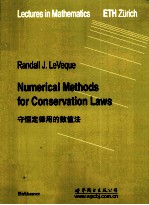

守恒定律用的数值法PDF电子书下载
- 电子书积分:10 积分如何计算积分?
- 作 者:(美)勒维克著
- 出 版 社:世界图书北京出版公司
- 出版年份:2010
- ISBN:9787510027406
- 页数:214 页
1 Introduction 1
1.1 Conservation laws 1
1.2 Applications 2
1.3 Mathematical difficulties 8
1.4 Numerical difficulties 9
1.5 Some references 12
2 The Derivation of Conservation Laws 14
2.1 Integral and differential forms 14
2.2 Scalar equations 16
2.3 Diffusion 17
3 Scalar Conservation Laws 19
3.1 The linear advection equation 19
3.1.1 Domain of dependence 20
3.1.2 Nonsmooth data 21
3.2 Burgers' equation 23
3.3 Shock formation 25
3.4 Weak solutions 27
3.5 The Riemann Problem 28
3.6 Shock speed 31
3.7 Manipulating conservation laws 34
3.8 Entropy conditions 36
3.8.1 Entropy functions 37
4 Some Scalar Examples 41
4.1 Traffic flow 41
4.1.1 Characteristics and "sound speed" 44
4.2 Two phase flow 48
5 Some Nonlinear Systems 51
5.1 The Euler equations 51
5.1.1 Ideal gas 53
5.1.2 Entropy 54
5.2 Isentropic flow 55
5.3 Isothermal flow 56
5.4 The shallow water equations 56
6 Linear Hyperbolic Systems 58
6.1 Characteristic variables 58
6.2 Simple waves 60
6.3 The wave equation 60
6.4 Linearization of nonlinear systems 61
6.4.1 Sound waves 63
6.5 The Riemann Problem 64
6.5.1 The phase plane 67
7 Shocks and the Hugoniot Locus 70
7.1 The Hugoniot locus 70
7.2 Solution of the Riemann problem 73
7.2.1 Riemann problems with no solution 75
7.3 Genuine nonlinearity 75
7.4 The Lax entropy condition 76
7.5 Linear degeneracy 78
7.6 The Riemann problem 79
8 Rarefaction Waves and Integral Curves 81
8.1 Integral curves 81
8.2 Rarefaction waves 82
8.3 General solution of the Riemann problem 86
8.4 Shock collisions 88
9 The Riemann problem for the Euler equations 89
9.1 Contact discontinuities 89
9.2 Solution to the Riemann problem 91
Ⅱ Numerical Methods 95
10 Numerical Methods for Linear Equations 97
10.1 The global error and convergence 102
10.2 Norms 103
10.3 Local truncation error 104
10.4 Stability 106
10.5 The Lax Equivalence Theorem 107
10.6 The CFL condition 110
10.7 Upwind methods 112
11 Computing Discontinuous Solutions 114
11.1 Modified equations 117
11.1.1 First order methods and diffusion 118
11.1.2 Second order methods and dispersion 119
11.2 Accuracy 121
12 Conservative Methods for Nonlinear Problems 122
12.1 Conservative methods 124
12.2 Consistency 126
12.3 Discrete conservation 128
12.4 The Lax-Wendroff Theorem 129
12.5 The entropy condition 133
13 Godunov's Method 136
13.1 The Courant-Isaacson-Rees method 137
13.2 Godunov's method 138
13.3 Linear systems 140
13.4 The entropy condition 142
13.5 Scalar conservation laws 143
14 Approximate Riemann Solvers 146
14.1 General theory 147
14.1.1 The entropy condition 148
14.1.2 Modified conservation laws 149
14.2 Roe's approximate Riemann solver 149
14.2.1 The numerical flux function for Roe's solver 150
14.2.2 A sonic entropy fix 151
14.2.3 The scalar case 153
14.2.4 A Roe matrix for isothermal flow 156
15 Nonlinear Stability 158
15.1 Convergence notions 158
15.2 Compactness 159
15.3 Total variation stability 162
15.4 Total variation diminishing methods 165
15.5 Monotonicity preserving methods 165
15.6 l1-contracting numerical methods 166
15.7 Monotone methods 169
16 High Resolution Methods 173
16.1 Artificial Viscosity 173
16.2 Flux-limiter methods 176
16.2.1 Linear systems 182
16.3 Slope-limiter methods 183
16.3.1 Linear Systems 187
16.3.2 Nonlinear scalar equations 188
16.3.3 Nonlinear Systems 191
17 Semi-discrete Methods 193
17.1 Evolution equations for the cell averages 193
17.2 Spatial accuracy 195
17.3 Reconstruction by primitive functions 196
17.4 ENO schemes 198
18 Multidimensional Problems 200
18.1 Semi-discrete methods 201
18.2 Splitting methods 202
18.3 TVD Methods 206
18.4 Multidimensional approaches 206
Bibliography 208
- 《FDS火灾数值模拟》李胜利,李孝斌编著 2019
- 《强度理论与数值极限分析》郑颖人,孔亮,阿比尔的著 2020
- 《巴拉巴西成功定律》匈牙利)艾伯特-拉斯洛?巴拉巴西 2019
- 《因果定律》刘雪涛责任编辑;墨非 2019
- 《数值天气预报的数学物理基础 第1卷》曾庆存 2019
- 《燃烧后二氧化碳捕捉技术流场数值模拟》杨丽,刘方著 2018
- 《复合材料随机多尺度分析数值方法与工程应用》文聘 2019
- 《舰船结构爆炸毁伤分析数值仿真与试验》吴卫国 2019
- 《海洋动力环境模拟数值算法及应用》王永学 2019
- 《地表水环境数值模拟与预测 EFDC建模技术及案例实训》李一平,龚然,(美)保罗·克雷格著 2019
- 《TED说话的力量 世界优秀演讲者的口才秘诀》(坦桑)阿卡什·P.卡里亚著 2019
- 《小手画出大世界 恐龙世界》登亚编绘 2008
- 《近代世界史文献丛编 19》王强主编 2017
- 《课堂上听不到的历史传奇 世界政治军事名人 初中版》顾跃忠等编著 2015
- 《指向核心素养 北京十一学校名师教学设计 英语 七年级 上 配人教版》周志英总主编 2019
- 《365奇趣英语乐园 世界民间故事》爱思得图书国际企业 2018
- 《近代世界史文献丛编 36》王强主编 2017
- 《北京生态环境保护》《北京环境保护丛书》编委会编著 2018
- 《近代世界史文献丛编 11》王强主编 2017
- 《近代世界史文献丛编 18》王强主编 2017
